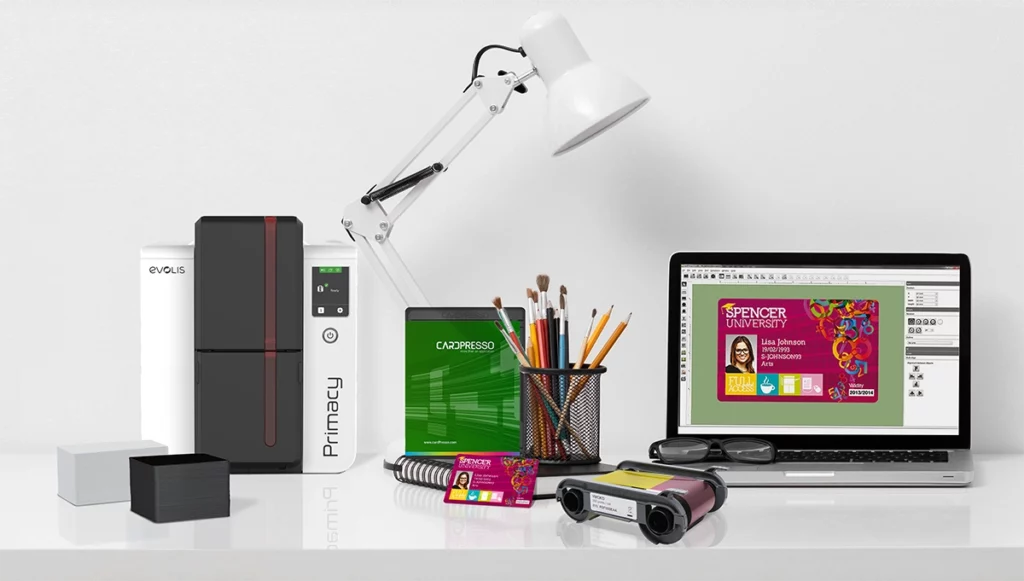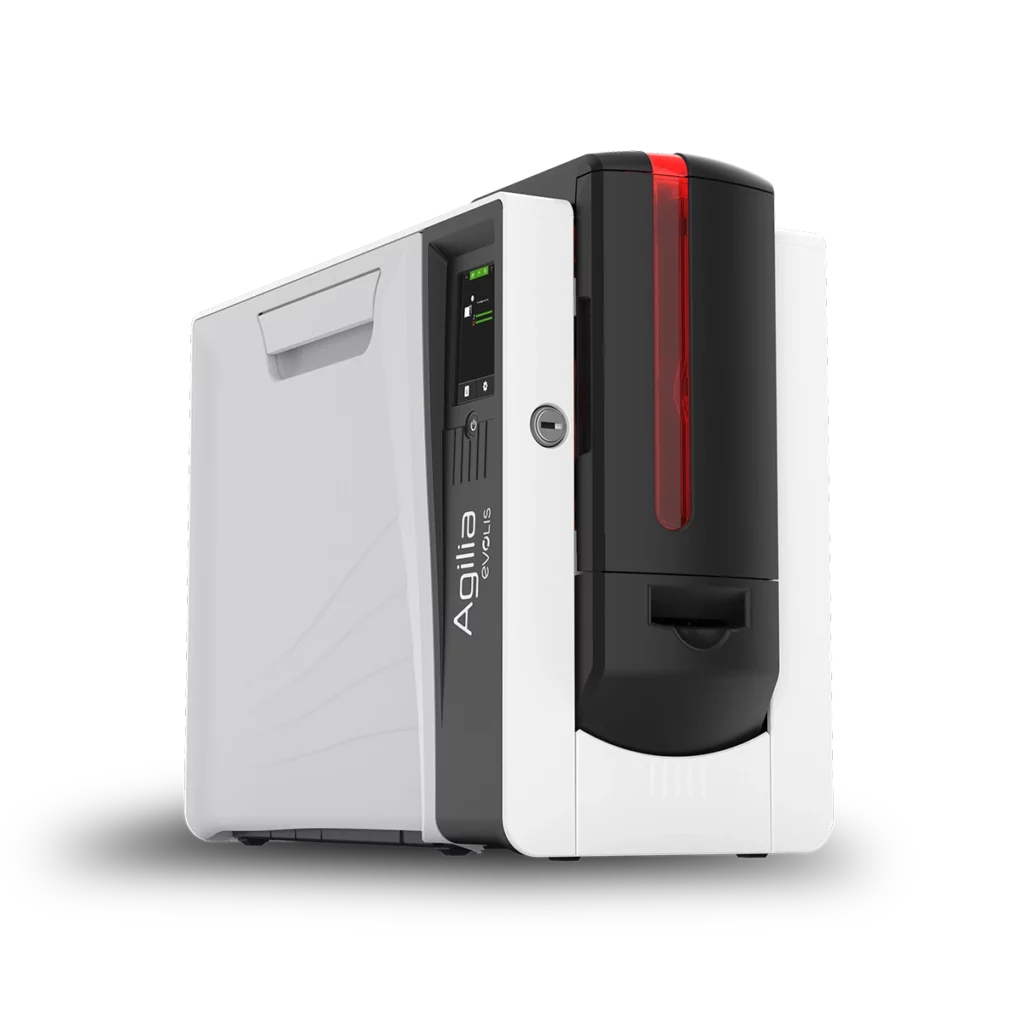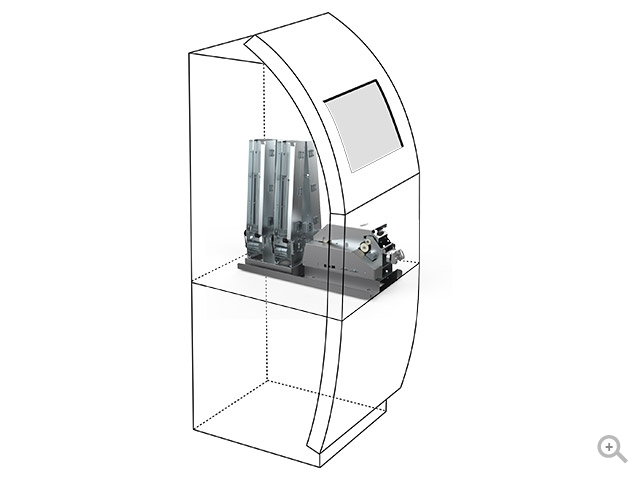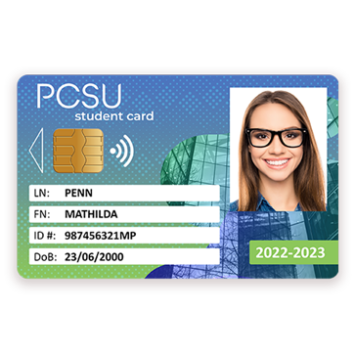Student ID card printing: 10 questions to ask yourself
Introduction
This article outlines the key criteria for student and staff identification at campuses and universities. It will guide you in selecting a student ID card printing solution tailored to your specific needs by addressing the right questions.
Summary
- What types of student ID cards should I choose for my institution?
- What budget should be allocated for student ID card printing?
- What design should I choose for student ID cards?
- Is my student ID card printing solution compatible with other information systems?
- What data management strategy should my institution use?
- Is my student ID card printing solution scalable?
- Is my student ID card printing solution secure?
- What printing technology should I choose for student ID cards?
- How should I distribute my institution’s student ID cards?
- Is my solution suitable for the needs of students and staff?
1. What types of student ID cards should I choose for my institution?
Universities welcome a wide range of people onto campus. Whether visiting daily (students, lecturers, cafeteria staff, maintenance personnel, etc.) or periodically (suppliers, service providers, guest lecturers, etc.), controlled access to specific buildings for different profiles of people requires the higher education institutions to issue a personalized card (electrically and graphically). It’s much more efficient to manage the issuance of these cards by defining user profiles, associated with a certain type of card. This means issuing cards with distinct characteristics, tailored to the user’s needs.

These characteristics must take into account several criteria:
- Which areas of my campus must the user have access to (classrooms, staff rooms, storage space, server room, etc.)?
- How long will the person use the card (1 day, 1 semester, years)?
- What level of security is required for the card?
- In addition to its access control function, will the card enable users
- to take advantage of additional services (printing, cafeteria, public transport,
- payment, etc.)?
- What card usage data do I need for statistical analysis (popularity of services, payment habits, etc.)?
These criteria will help you determine the different types of cards you need to issue based on your user profiles.
2. What budget should be allocated for student ID card printing?
The budget required from higher education institutions for issuing their cards generally depends on 2 main criteria:
- the size of the student population
- the features required.
To optimize this budget in order to offer quality service at a reasonable cost, here are a few tips:
- ESTIMATE: This is an important step in avoiding unpleasant surprises (as far as possible). You can, for example, relate the overall cost of issuing your cards to the cost per person, to help you stay within your target budget
- PRIORITIZE: Which features and services do you consider indispensable? And, on the contrary, which ones could you possibly do without? Make a list and assign a degree of priority for each feature.
- ON-SITE ISSUANCE: Using external service providers or suppliers is generally more expensive than printing cards on campus. So it’s a good idea to ask yourself what tasks your employees can easily perform themselves to keep your costs down.
- MAKE IT PROFITABLE: The student ID cards you issue can be a source of revenue. In fact, if you opt for a predominantly digital experience, you’ll still need to offer an associated physical card for those students who want/need it. In this way, the card may be subject to a charge and become a source of revenue.
3. What design should I choose for student ID cards?
The choice of design for your cards is not insignificant: it reflects the brand image and values of your institution. It conveys your visual identity and makes you recognizable, especially since the image conveyed by universities is an important criterion for students in their choice of higher education institution.
The various graphic elements that make up the design must therefore be chosen with care to ensure an aesthetically pleasing overall composition. They can be grouped into 5 main categories:
- IDENTITY: Your logo is the graphic representation of your establishment, your brand. It is therefore essential that it be present on the cards you issue, as a central element of your identity.
- PERCEPTION: It’s important to take into account the connotations of colors when creating the design of your cards (while adhering to your graphic or branding guidelines, where applicable). The colors you choose reflect the image you convey.
- SECURITY: The presence of superior security elements helps to project a qualitative, even prestigious, image of your establishment.
- UNIQUENESS: The different cards you issue (according to user profiles) must stand out not only from each other but also, and above all, from those of other universities, which may represent a form of competition.
- QUALITY: Quality is not just a question of design, but also of printing. The final rendering of the card, once printed, must live up to your brand image.

To create the perfect design for your cards, you can outsource the creation to a professional designer. For greater autonomy, you can also create it yourself, using a student ID card personalization software. Depending on the card printer you choose, this software may be supplied.
4. Is my student ID card printing solution compatible with other information systems?
Your card-issuing solution must be able to work with other existing or future systems, without restricting access or implementation: this is known as interoperability. In particular, it guarantees compatibility between the cards issued and the various terminals with which they will communicate.

System interoperability is essential to guarantee the independence of your card issuing system and its scalability for the future. It must be able to meet your specific requirements, without making you dependent on the solution provider. What’s more, it must be capable of adapting to new needs and technologies.
5. What data management strategy should my institution use?
Data management is a comprehensive process that involves collecting, storing, and using data securely and efficiently. It can be managed in-house, outsourced to a supplier, or even organized as a hybrid.
Let’s weigh the pros and cons of these 3 types of solutions:
- IN-HOUSE: On-site management of your data means you do not share it with a third-party supplier. You keep all your data and have greater control over its management. On the other hand, this mode of operation requires you to develop certain technical skills in-house that are essential to good data management. You will also require a set of relevant IT equipment (server, software, etc.). As a result, the cost can be higher than for external data management.
- OUTSOURCED: Setting up an outsourced data management solution is easy, and often represents good value for money. The costs associated with managing your data are fully covered by the chosen solution provider (you only pay the subscription fee and set up the data management rule). This type of solution is usually managed via the cloud, giving you remote access to all your data. However, by outsourcing your data management, you become dependent on the chosen provider and the availability of its service. What’s more, the data is shared with the provider, and passes under their control
- HYBRID: Some IT environments combine on-premise applications with a cloud service. The advantages and limitations of both models apply equally.
Data management comparison chart
| In-house | OUTSOURCED | HYBRID | |
|---|---|---|---|
| Pros | Direct control, increased confidentiality, adaptability to specific needs. | Reduced costs, remote access via the cloud, automatic updates. | Flexibility, cost reduction, direct control over certain data. |
| Cons | High costs, need for internal technical skills, risk of data loss. | Reliance on the provider, heightened security risks, potential for service disruption. | Potential complexity, ongoing dependence on cloud providers. |
Whichever solution you choose, you remain responsible for data confidentiality and you must know exactly where your data will be hosted. The regulations in force in your country also provide you with a list of your obligations for data management in full compliance.
Looking to print your own student ID cards for your institution?
6. Is my student ID card printing solution scalable?
If you’re considering decentralized card issuing , or if you already have, we strongly recommend that you choose scalable card printers. Why would you do this? So that they can evolve in step with your needs, your establishment, the expectations of cardholders and especially students, technology advancements, etc.
The ability of your card-issuing solution to evolve over time will enable you to:
- MEET YOUR NEW NEEDS WITH: Some card printers on the market can easily integrate new options and features, directly on site. Rather than changing equipment, you can upgrade the one you already have: it’s economical, practical, and environmentally friendly.
Example: ability to print on both sides, addition of a lamination module, new encoding modules, etc.
- INCREASE YOUR PRODUCTION, BY INTEGRATING NEW CARD PRINTERS: The number of people you welcome in your establishment may increase over the years. As a result, your need for cards may also increase. So it’s vital that the solution you deploy can easily accommodate new card printers in its environment.
Example: desktop printers, self-service kiosks, custom solutions
7. Is my student ID card printing solution secure?
The consequences of an insufficiently secure installation can be disastrous, especially where data is concerned: loss or misuse of data, fraudulent payment, identity theft, etc.

To optimize your system’s security, we recommend the following:
- LIMIT ACCESS: Give access rights to your system only when really necessary. The more you limit the number of people who can access your system, the lower the risk of human error or mischief.
- CLASSIFY DATA: Identify the most sensitive data and provide extra security, using encryption for example.
- ENSURE REGULAR CLEAN-UP: Regularly delete unused data to prevent it from remaining accessible. This can also save you money, as the cost of your solution likely depends in part on the amount of data stored.
- MONITOR POTENTIAL CYBER-THREATS: Put in place a cyber-security policy that enables monitoring and includes the actions to be taken in the event of an attack. Specialized tools exist to alert you in real time to suspicious events.
8. What printing technology should I choose for student ID cards?
There are different card printing technologies. Depending on the end result you want
to achieve and the future use of your cards, one technology will be more suitable than another.
Sometimes, it’s even worth combining them to cover all your needs.
- D2T2: Also known as “direct-to-card printing“, the ink in the ribbon is deposited directly on the card by a process known as sublimation. This technology is the most common, and therefore also the most affordable, and offers quality printing with a resolution of 300 dpi. Depending on the printer chosen, certain security features, such as a UV effect, can be applied directly to the card.
- RETRANSFER: Also known as “reverse transfer“, this printing technology is a two-step process. First, the card design is printed onto a film, which is then transferred to the card. Retransfer enables exceptional print quality of 600 dpi, and printing on different card materials (PVC, composite PVC, PET, polycarbonate…)
- REWRITE: Rewrite enables to personalize rewritables cards, simply by using a thermal process, which makes the ink contained directly in the card appear and disappear. The rewritable card can therefore be erased and reprinted many times (depending on how the card is used). So it’s both economical and environmentally friendly
To find out all about rewrite, download the free dedicated guide

Rewrite technology
(Rewritable cards)
9. How should I distribute my institution’s student ID cards?

The student card issuing period can generate a large flow of people. There are different ways of producing and issuing these cards, to help you manage the flow of people into your buildings.
- INSTANT ISSUANCE AT THE RECEPTION DESK: Each student ID card is personalized and printed on demand by a member of the card office staff. Most of the time, this mode of operation takes place at a reception desk, using a desktop card printer. The card is hand-delivered to the student during normal business hours.
- INSTANT ISSUANCE VIA SELF-SERVICE KIOSK: The student card is also personalized and printed instantly, but the student obtains the card autonomously. The self-service terminal is equipped with a card printer specifically developed for this purpose. Students can take advantage of this service during extended opening hours.
- DECENTRALIZED INSTANT MASS PRODUCTION: Card personalization and printing are carried out in batches, in advance. Typically, several card printers are deployed for productivity purposes, usually in a dedicated area with restricted access. The card is then ready when the student comes to pick it up. This type of mass production requires a complete and accurate database.
These different student card production and delivery solutions can be combined, giving you even greater flexibility and efficiency.
10. Is my solution suitable for the needs of students and staff?
Like all generations, the “digital natives” have very specific aspirations. Here are a few ideas that reflect the main expectations of Generation Z students:
- FOCUS ON VALUES: Generation Z students are quite sensitive to the notion of “values” and are all the more inclined to choose a university that asserts its convictions and doesn’t hesitate to display them. The student card can be one of the ways in which you can communicate your commitments and give your institution a prestigious image.
- PROMOTING INCLUSION: Promoting inclusion: this is a real issue, and there are many components to consider (to find out more, download our dedicated white paper). Among them, gender is a major one: 60% of Generation Z members think that gender options on forms should not be limited to “Male / Female” . It may therefore be worth taking this into account when adapting your forms.
- PROTECT THE ENVIRONMENT: “Generation Z firmly believes that mankind is the cause of climate change”2 . With this in mind, you could, for example, collaborate with an organization working to protect the environment and create a dedicated student card. This type of action already exists in the banking sector, and it would be highly appropriate to extend it to the education sector.
- SPEND WISELY: One of Generation Z’s main purchasing criteria is price . So they don’t hesitate to turn to second-hand stores and thrift shops, for example, which not only save them money, but also enable them to find unique styles. To further this trend, you can establish partnerships with retailers who support this approach, so that your students can benefit from discounts on presentation of their card.
These ideas are designed to help you develop a comprehensive solution, tailored to your needs and ambitions, and to help you stand out from the crowd.
Find out more about inclusion and security in higher education insitutions in our free dedicated white paper :

Will the smartphone kill the student ID Card?
Our Choice for Student ID Card Printing
There are several solutions available for printing your student ID cards. At Evolis, we offer card printers tailored to your needs and those of your institution, such as campuses or universities. Here are the printer models we recommend for printing your student ID cards:
Evolis Card Printers for Campuses and Universities

Agilia
The Evolis retransfer card printer. Equipped with the latest printing technology, it delivers the highest quality for your cards.

Primacy 2
The versatile Evolis card printer. Features rewritable “Rewrite” card technology and offers high-speed printing.
Comparison Table of Agilia and Primacy 2 Printers
| Agilia | Primacy 2 | |
|---|---|---|
| Usage | Medium to large series, High print quality | Medium to large series, High print speed |
| Printing Technology | Retransfer (Reverse transfer) Thermal sublimation | Rewrite (Rewritable cards) Thermal sublimation |
| Print Resolution | 600 dpi | 300 dpi |
| Print Speed | Single-sided: 150 cards/hour Double-sided: 100 cards/hour | Single-sided: 280 cards/hour Double-sided: 170 cards/hour |
| Feeder Capacity | 200 cards | 100 cards 200 cards (optionnal) |
| Output Hopper Capacity | 100 cards | 100 cards |
| Encoding Options | Magnetic Contact chip Contactless chip (RFID) Dual chip (with and without contact) | Magnetic Contact chip Contactless chip (RFID) Dual chip (with and without contact) |
| Lamination (Security) | CLM lamination module (optional) Lamination Holograms | CLM lamination module (optional) Lamination Holograms Kineclipse (Anti-fraud) |
| Software | Included (cardPresso XXs) | Included (cardPresso XXs) |
| Manufacturer’s Warranty | 3 years, Lifetime print head warranty | 3 years |
Self-service kiosks for campuses and universities

Self-service kiosk :
KC Essential – KC Prime – KC Max
A self-service kiosk with excellent value for money

Self-service kiosk :
KM500B – KM2000B
An autonomous self-service kiosk with high card capacity
Need help choosing your Evolis card printer? Contact us!



